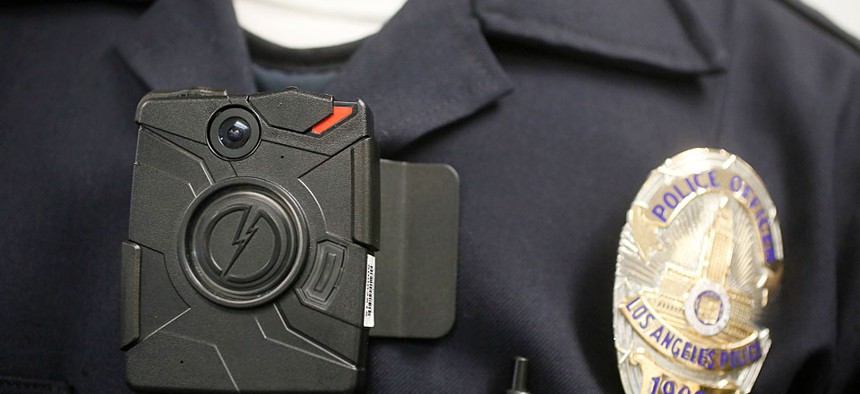Do Police Body Cameras Actually Work?

A Los Angeles Police officer wearing an on-body cameras during a demonstration for media in Los Angeles. Damian Dovarganes/AP
After Ferguson, the president is betting millions on a technology that's still being tested around the world.
It may be the most significant reform to follow the fatal police shooting of Michael Brown.
On Monday, President Obama requested $75 million in federal funds for a technology that, as he sees it, could help bridge the kinds of rifts between the police and public that surfaced in Ferguson, Missouri. It's a technology that Brown's own family has championed as a "positive change" that could result from the teen's death. The White House has proposed distributing some 50,000 body cameras to police departments across the country, since "evidence shows that body worn cameras help strengthen accountability and transparency, and that officers and civilians both act in a more positive manner when they're aware that a camera is present."
But does the evidence actually show this? A grand jury's decision on Wednesday to not indict an NYPD officer for placing Eric Garner in a deadly chokehold in Staten Island brought out the skeptics. The chilling confrontation wasn't caught on a body-worn police camera, but it was filmed by a bystander:
Over and over again police shootings caught on camera and no indictment comes.Body cameras don't mean accountability. http://t.co/tgWtF8TFFi
— Nikole Hannah-Jones (@nhannahjones) December 3, 2014
Eric Garner's death WAS captured on video. We all saw it. Body cameras for cops won't solve this problem. It's bigger than technology.
— ∇ ▼Jenna Wortham ▼∇ (@jennydeluxe) December 3, 2014Barak Ariel, a criminologist at the University of Cambridge, isn't so sure about body cameras, either.
The technology is "surely promising, but we don't know that it's working," Ariel told me. The Food and Drug Administration doesn't approve drugs until they've been studied extensively, he explained, and governments should take a similar approach with body-worn cameras. It's a solution that has yet to be proven.
Ariel should know. He's currently researching the effects of body cameras on policing everywhere from Brazil to Ghana to Israel to Northern Ireland, and finding that some police departments (and police unions) love the idea and others hate it. Nearly all of these tests have yet to be completed, but Ariel recently co-authored a study on the practice in Rialto, California, where he found that police officers who weren't wearing cameras were twice as likely to use force as those who were. During the 12-month experiment, the police department also saw a reduction in citizens' complaints compared with previous years. The researchers concluded that the benefits of wearing cameras trumped the costs.
But Ariel insists that there isn't enough evidence so far to generalize the finding and assert that body-worn cameras offer a net benefit to community policing. The Rialto report, for example, was the world's first randomized-controlled trialinvolving the technology.
Consider the costs, both calculable and incalculable. There's the hefty price tag for the cameras (around $800 to $1,000 each) and the systems to store and sift through the data they collect. Equipping frontline police officers across the U.S. with cameras, and paying the monthly subscription fees for their use and upkeep, could cost billions of dollars, Ariel estimated.
There are also privacy concerns—the fear, as one editorial in Canada's Globe and Mail recently expressed it, that cameras "could turn every officer into a mobile, closed-circuit camera, hooked up to a database tracking and recording people’s movements across the city." People could refrain from reporting incidents to the police because they don't want to appear on camera. Ariel is less worried about increased surveillance—"I don't think there's a single street in London that isn't covered by CCTV [closed-circuit television]," he points out—than about what data is stored and how that evidence is used. Those are questions that each country's legal system will have to sort out.
There is another potential cost to widespread adoption of body-worn cameras: The credibility of police testimony against defendants could be discounted in the absence of footage to corroborate the officer's version of events. It's the legal equivalent of "pics or it didn't happen."
Ariel gave the example of a traffic cop who spots an infraction out of the corner of his eye, and then can't produce body-worn video of the episode. In that scenario, a judge could toss out the case for lack of evidence. "That has serious implications for policing and the status of officers' testimony and statements in the court of law," he said.
The benefits are poorly understood as well. As Ariel and his co-authors wrote in their report on Rialto, it's clear that body cameras reduced the likelihood of forceful interactions between officers and citizens. But it's unclear whether the cameras had a deterrent effect on the police, the public, or both, and how those effects interacted with one another. "Do cameras affect the conduct of suspects, which then moderates the need of officers to react with force to such behavior?" they asked. "Or do cameras affect the conduct of officers, who might have otherwise acted with unnecessary or excessive force regardless of the suspects’ demeanor? Does it have a double effect?"
Earlier this year, Michael White, a criminologist at Arizona State University, arrived at similar conclusions in a study for the Department of Justice. He reviewed five studies, including Ariel's, which represented "the entire body of evidence on body-worn cameras." Citing a lack of "rigorous, independent studies using experimental methods," he concluded that "there is not enough evidence to offer a definitive recommendation regarding the adoption of body-worn cameras by police," and that "most of the claims made about the technology are untested."
White noted that the first experiments with body-worn cameras took place in the English city of Plymouth in 2005 and 2006, and then in the Scottish cities of Aberdeen and Renfrewshire in 2011. The results were encouraging but incomplete and inconclusive. U.K. officials found "that citizen behavior improves as a result of officer body-worn cameras," White wrote, but "the evidence used to support this statement is not clear." The Plymouth and Renfrewshire/Aberdeen trials produced a decline in citizen complaints against the police. But was the number of complaints lower because cameras put police and the public on their best behavior, or because they discouraged citizens from reporting grievances? The studies didn't say.
The results in Rialto have been cited in the media as proof that police body cameras work. But Rialto isn't reproducible the world over. As Ariel and his fellow researchers note, the city's police department is relatively small, and the police chief directly oversaw the experiment. Likewise, success in the U.K., where one person was killed by police in 2012, doesn't necessarily translate to success in the U.S., where at least 410 people were killed by police that same year.
I asked Ariel why the concept of body-worn cameras has caught on in the absence of definitive proof of their value. Police officers, he explained, see a means of verifying, via a third-party technology, that they responded to incidents in an appropriate fashion. Governments see an opportunity to save money on things like litigation costs. Citizens see a way to ease chronic tensions between the public and police.
"There's an appeal to [the camera] because it makes logical sense," he observed. "Now, between logical sense and evidence that actually supports it, there's quite a difference."






